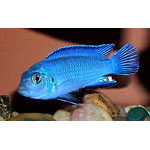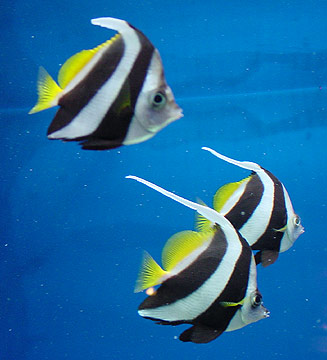Socolofi blue

|
Scientific Name: Pseudotropheus socolofi Price: Upon Request Origin: Lake Malawi¸ Mozambique coast Family: Cichlidae NOT AVAILABLE NOW |
|
Other Names: Powder Blue cichlid, Pindani, Socolofi, Eduard’s mbuna |
|
Technical Info
Temperature: 24 - 28 ℃
pH: 7.5 - 8.3
GH: 10 - 25
Max size: 10 cm
Min Tank size: 100 Ltr
Position in Aqua: No special swimming level
Description
Socolofi blue is a fairly well-known and popular fish among the cichlid community. Both males and females of the species have a light blue body with the males usually having a brighter blue sheen. Both sexes also display egg spots on the anal fin with the males again having brighter, more sharply defined coloration. The dorsal fin usually has a dark band with a lighter edge and the body may contain several darker vertical “stripes.”
Food
It will accept most foods offered but vegetable matter in the form of spirulina flakes, blanched spinach, nori etc. should form a large proportion of the diet. This can be supplemented with live and frozen varieties. Never feed beefheart or any other red meat as it will interfere with the digestive system of these fish.
Breeding
Mouth-brooder. The species may become very aggressive while spawning. The female will brood for approximately 3 weeks and gives birth too up too 60 fry. You can tell if a female is brooding by her enlarged mouth and the fact that she isn’t eating. The female cares for the fry 2 weeks after they first leave her mouth. Fry accepts most kinds of food. Brooding females can be isolated for more productive breeding. It is recommendable to try to make the isolation as short as possible to avoid that the females loses their social status which may cause fights once they are returned. Stress might cause the females to eat eggs and fry. Some fry may survive in a community tank.
Compatible with
Not especially aggressive for a mbuna although still unsuited to the general community tank. It should not be kept with large or aggressive mbuna. Good tankmates include Aulonocara, Copadichromis and quieter mbuna such as Labidochromis caeruleus. Male fish are territorial and a large aquarium is required if you wish to keep more than one. Each male should be provided with several females.
Note
It is one of the most popular Rift Lake cichlids in the hobby due to its striking colouration and somewhat peaceful nature (for a mbuna).

